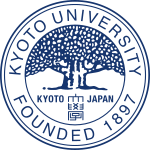
Back Universiteit van Kioto Afrikaans جامعة كيوتو Arabic جامعة كيوتو ARZ Universidá de Kioto AST Kioto Universiteti Azerbaijani کیوتو بیلیمیوردو AZB Киото университеты Bashkir Univérsitas Kyoto BAN Кіёцкі ўніверсітэт Byelorussian Кіёцкі ўнівэрсытэт BE-X-OLD
京都大学 (Japanese) | |
 | |
| Motto | 自由の学風 |
|---|---|
Motto in English | "Freedom of academic culture"[1] |
| Type | Public (national) |
| Established | June 18, 1897 |
| President | Nagahiro Minato[2] |
Academic staff | 4,062 (teaching staff)[3] |
Administrative staff | 3,658 (total staff)[3] |
| Students | 22,426[3] |
| Undergraduates | 12,852[3] |
| Postgraduates | 9,574[3] |
| Location | , Kyoto , Japan 35°01′34″N 135°46′51″E / 35.026212°N 135.780842°E |
| Campus | Urban, 135 ha (333 acres) |
| Athletics | 48 varsity teams |
| Colors | Navy blue[4] |
| Nickname | Kyodai |
| Affiliations | Kansai Big Six, ASAIHL |
| Website | www |
 | |
Kyoto University (京都大学, Kyōto daigaku), or KyotoU (京大, Kyōdai), is a national research university located in Kyoto, Japan. Founded in 1897, it is one of the former Imperial Universities and the second oldest university in Japan.
The university has ten undergraduate faculties, eighteen graduate schools, and thirteen research institutes. The university's educational and research activities are centred in its three main campuses in Kyoto: Yoshida, Uji and Katsura. The Kyoto University Library Network, consisting of more than 40 libraries spread across its campuses,[5] has a collection of more than 7.49 million books,[6] making it the second largest university library in the country.[7] In addition to these campuses, the university owns facilities and lands for educational and research purposes around the country.[8]
As of 2024, Kyoto University counts two Prime Ministers of Japan amongst its alumni. Additionally, three Prime Ministers of Japan attended the Third Higher School, a university preparatory school that merged into KyotoU in 1951. 19 Nobel Prize laureates, two Fields Medalists, one Gauss Prize winner, and five Lasker Award recipients have been affiliated with KyotoU either as alumni or faculty members.
- ^ "Kyoto University Basic Concept for Internationalization". Kyoto University. Retrieved 2024-02-11.
- ^ "Profile of President Nagahiro Minato". Kyoto University. Retrieved 12 November 2020.
- ^ a b c d e "Kyoto University Facts and Figures 2021-2022" (PDF). Retrieved 2022-05-07.
- ^ Kyoto University Visual Identity Guidebook (PDF) (1 ed.). October 1, 2018. p. 8.
- ^ "Kyoto University Library Network". www.kulib.kyoto-u.ac.jp. Retrieved 2024-02-11.
- ^ "蔵書数等" (in Japanese). Kyoto University. Retrieved 2024-02-11.
- ^ "図録▽大学図書館蔵書数ランキング". honkawa2.sakura.ne.jp. Retrieved 2024-02-11.
- ^ "大学の施設" (in Japanese). Kyoto University. Retrieved 2024-02-11.